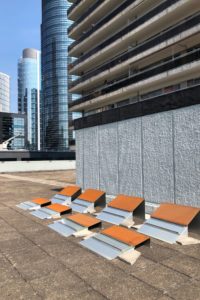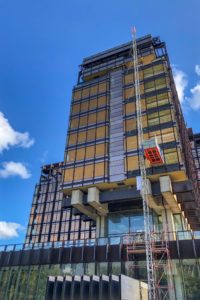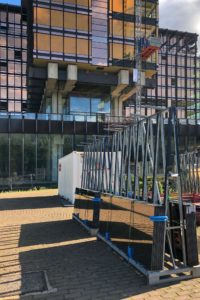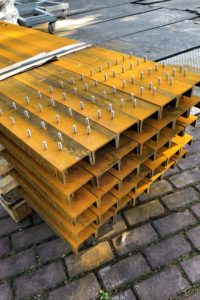Royale Belge : challenges encountered
Built in the 60’s by the famous architects P. Dufau (Paris) and R. Stapels (Brussels), the former offices of the Royal Belge are now an iconic building of Brussels. Fifty years after their inauguration (March 1970), a renovation was necessary. The will of the Brussels authorities, Souverain 25 and the group of architects was to magnify the heritage value of the building; the renovation will be done identically. Two singularities, contributing to the emblematic character of the building, constitute challenges for the team in charge of the project: the Corten steel of the facades and the copper-colored glazing (Glaverbel, Stopray Gold).
The Royale Belge building has the particularity of having an apparent supporting structure. This exoskeleton, as well as most of the facade finishes, are made of Corten steel. This material, developed and patented in 1932 by an American company, is a so-called "self-patinated steel with induced surface corrosion". The oxidation of Corten steel occurs naturally in +/- six months, then stabilizes over time. This envelope of surface rust naturally protects the metal and gives it excellent resistance to bad weather; no additional treatment is necessary. For the Royale Belge, if the supporting structure does not require any intervention, the finishing sheets and frames will have to be replaced. For six months, we will be able to watch these new Corten steel parts gradually rust, alongside the original ones. In order to guarantee a perfect renovation, we studied the way the other facade materials would react during this oxidation period. Kyotec Group, the company responsible for the renovation of the facade, carried out tests on the roof of their office in Brussels to see how the process would unfold.
The copper-colored glazing was chosen at the time of the building's design because of its solar protection characteristics. While this tint made the exterior façade attractive, the light transmission inside was relatively low and the coloring of the view to the outside no longer meets today's expectations. All the glazing will therefore be replaced identically from the outside while offering a neutral coloring from the inside. This technical feat was custom-made by AGC company.
The planning permission having been delivered at the beginning of August, the building site started at the beginning of September.
Realization:
KYOTEC GROUP, facade designer
AGC + POLYPANE, glazing
ARCELOR MITTAL, manufacturer of the Corten steel
CIT Blaton, general contractor




